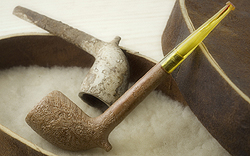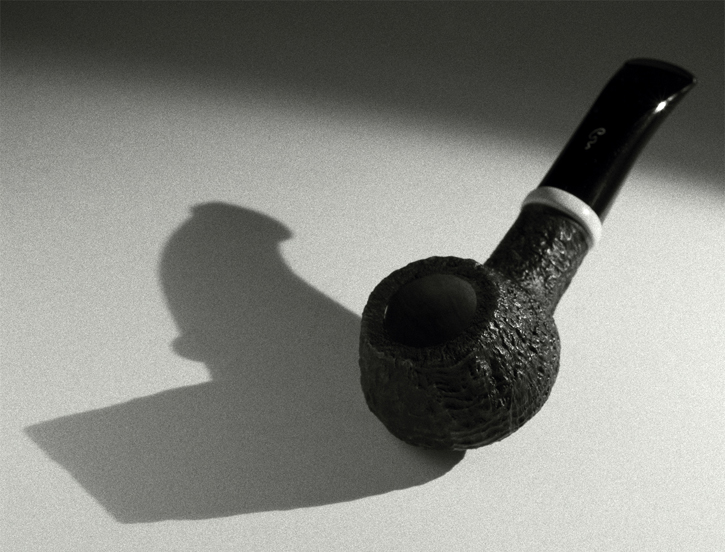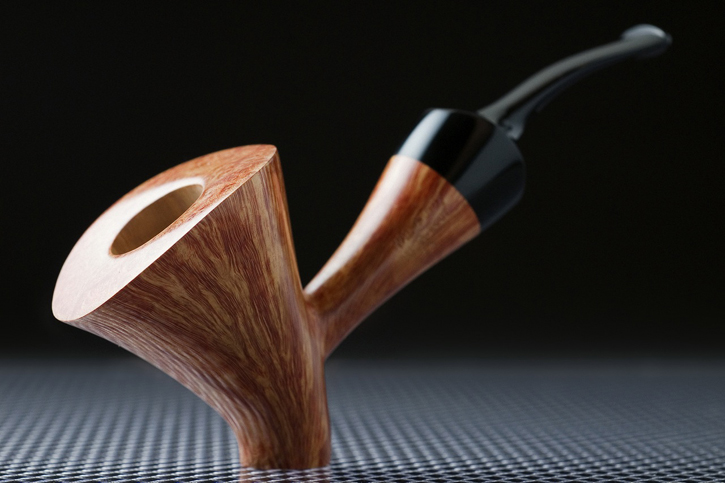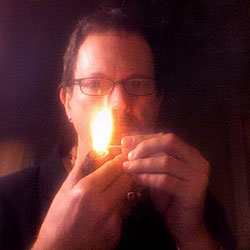By G. L. Pease
 When I first took up the pipe, and more specifically, the pernicious disorder known as pipe-collecting, I was counseled by a couple grizzled old guys, meaning they were then older then than I am now, that pipes were better back in the day. They patiently explained to me, the wide-eyed, enthusiastic youth, that in the old days, good pipes were made from prehistoric briar, constructed by craftsmen who began their apprenticeships in utero, and that modern pipes are no more worthy of their attention than a Starving Artist’s rendition of Cézanne’s Man With a Pipe bought out of the trunk of a beat-up Chevy in a Home Depot parking lot. They’d contentedly puff away at their ancient briars as they would tell me of the good old days, and how it’s too bad pipe smoking was a dying art, and that pipe making, real pipe making, was already dead, and just hadn’t had the grace to get buried yet, and how it was too bad that I’d missed out on the Golden Age. (I bet when they were kids, someone told them the same thing.)
When I first took up the pipe, and more specifically, the pernicious disorder known as pipe-collecting, I was counseled by a couple grizzled old guys, meaning they were then older then than I am now, that pipes were better back in the day. They patiently explained to me, the wide-eyed, enthusiastic youth, that in the old days, good pipes were made from prehistoric briar, constructed by craftsmen who began their apprenticeships in utero, and that modern pipes are no more worthy of their attention than a Starving Artist’s rendition of Cézanne’s Man With a Pipe bought out of the trunk of a beat-up Chevy in a Home Depot parking lot. They’d contentedly puff away at their ancient briars as they would tell me of the good old days, and how it’s too bad pipe smoking was a dying art, and that pipe making, real pipe making, was already dead, and just hadn’t had the grace to get buried yet, and how it was too bad that I’d missed out on the Golden Age. (I bet when they were kids, someone told them the same thing.)
One of the “old guys” steadfastly refused to smoke any pipe made after the start of WWII. When I asked him why, he told me that it was because of the quality of the mouthpieces. “See, for one thing” he’d begin, pulling a crusty, blackened old briar that reeked of the ages from between his teeth, pointing to a chewed up mouthpiece that looked like a materials-science project gone awry, “this old rubber tastes better when it goes green. The new stuff just doesn’t taste right.” I’ve kept my mouthpieces polished to a glassy shine ever since that particular lecture. “And, those plastic things? They just crack when you chew on ‘em. Look at this.” I did, trying to conceal any hints of revulsion. “This mouthpiece was made in ought-nine, and is still perfectly usable.” I didn’t tell him that it looked like a replacement to me. Did I mention the reek? I guess, along with acrylic stems, they didn’t make those newfangled pipe cleaners in ought-nine either.
Granted, my old friend’s position was probably a bit off center, and certainly extreme, but the idea that pipes made in the good old days were better than today’s is still often expressed, if a little more gently, by some of those who have been around the briar patch a lot longer than I have. The question remains, is there any truth the idea that old pipes were better?

I do have some very old pipes in my collection, one of the most ancient being a Dunhill prince from about 1918. It’s an absolutely wonderful pipe in every respect. It’s beautifully made and delivers a rich, cool, delicious smoke, but is it great because it was made when briar was “better?” Or, is it great because it’s been smoked for decades? Or, is it great just because it is?
Truth is, from here, it’s impossible to draw any rational conclusion along the lines of “pipes were better fifty years ago.” Unless we suddenly gain access to many unsmoked pipes from those allegedly halcyon days, all we have to base this opinion on is anecdotes and estate pipes, and both of these have their own set of problems.
Over the years, I’ve had the opportunity to break in quite a few old pipes, and it’s been something of a mixed bag. A couple of beautiful GBDs from the 40s were very tough going, offering harsh flavors during the first dozen bowls or more, then finally settling down a bit, but never rising to the level of ‘great smoker,’ either because I haven’t smoked them enough, or because the briar wasn’t all that great to start with. In contrast, an unsmoked Parker from the 30s was brilliant from the beginning. In between these two extremes, an unsmoked Charatan (not a high-grade) from the 50s was quite good, but nothing to get excited about. I’ve also broken in quite a few French pipes, finished relatively recently from bowls originally turned the 30s, that have ranged from very good to excellent. But I don’t rate their taste as particularly ‘better’ than the best pipes of today. There are plenty more I could talk about, some good, some not so good. Obviously, this isn’t anything that could masquerade as a real study. My sample isn’t large, nor carefully selected, and any conclusions I might draw would be tentative, at best. But, if I were to state a verdict, one with any support at all, it would simply have to be this: Some old pipes were good, some weren’t. Conversations with quite a few other pipe collectors, some who have been around a lot longer than I have, have resulted in the same non-conclusion.

What about today’s pipes? I have somewhat more experience there to draw from, as well as stories from pipe smoking comrades, and the community at large. I’ve smoked everything from conservatively priced factory-made pipes to somewhat exotic high-grades. Some have been great, a very few have been terrible, and most have fallen somewhere between acceptable and very good. Statistically, some brands have produced a higher number of “keepers” for me than others, and that I’ve had very few bad experiences with pipes from low-volume craftsmen who select and age their briar carefully, and pay the most attention to construction details that can affect a pipe’s smoking characteristics. So, some great, some not so much; nothing conclusive here, either.
A couple of things have to be said about estate pipes, and why we can’t really use them to judge the relative merits of yesterday’s pipes with today’s. First, the most obvious thing; someone else did the sometimes painful work of breaking the thing in. As much as I enjoy the first bowls in a new pipe, they’re never the best. As the pipe is broken in, as the wood seasons, absorbing the oils and aromatics from the tobacco and displacing any saps that might remain from the boiling and curing, as a cake begins to form, a good pipe begins to get richer, cooler, more delicious. Simply said, the more a pipe is smoked, providing it’s taken care of, the better it becomes. But, there’s something possibly even more important to consider.
Fifty years ago, when pipes were almost as commonplace as hats amongst adult men, factories bought briar by the ton and produced millions of pipes each year. Even as late as the 1970s, few collected pipes as hobbyists; most just smoked them, filling them with tobacco, lighting them, puffing on them until they went out, and starting over. Pipes were a tool, and if the tool didn’t perform, they’d go in the bin. Think about it. Where are those tens of millions of pipes today? When we buy an old estate pipe today, we’re selecting from an inventory that’s already been culled, that’s gone through the purging of the decades. The good ones have survived, and, having been smoked for so many years, they’re likely to be pretty good, indeed. Let’s look at some other factors.

It’s true that fifty years ago, good, mature briar burls were likely much more plentiful. Pipe makers and briar cutters alike tell me that the good burls are harder to find, harder to harvest now, and there aren’t as many people willing to do the arduous work. But, the demand isn’t as great today as it once was, either. Fifty years ago, there were a lot more pipe smokers, and factories turned out millions of pipes every year to meet the demand. Given that sort of volume, it’s hard to imagine, though I’m only speculating here, that the briar could have been consistently selected with excruciating care, aged and seasoned perfectly, and then fashioned into exquisite smoking instruments by highly skilled artisans into uniformly superb pipes. Certainly, some factories took greater care with all aspects of production, others, less.
Today, with fewer than 1.5 million pipe smokers estimated in the US, and the largest factories turning out fewer than 100,000 pipes per year, the demand for briar is obviously much lower. Briar cutters can be more selective, and have developed greater skills and understanding of the wood. Pipes makers, too, are more sensitive to the wood they use, and how they use it. Because of lower volumes, they can select more carefully, and many have developed their own special curing and seasoning methods to increase the chances of a great smoking pipe.
Additionally, today’s pipe makers have learned from their predecessors, and many have raised the bar with respect to things like airway construction, chamber geometry, overall performance, and even comfort. I can say without hesitation that some of the more recently made pipes in my collection are the equal of any of the best pipes I’ve ever owned, if not even better.
So, are old pipes better than new pipes? It depends on the pipes, and probably on the pipe smoker, himself. Back to the same non-conclusion.

Another thought. In considering old pipes being “better,” we can’t neglect the influence that nostalgia might offer, especially amongst estate pieces. I’m the first to admit that I often am transported on waves of wistful reverie when I smoke my oldest briars, wondering about where those pipes have been, who might have smoked them, what the world was like when they first came into being. It’s a different form of pleasure, but one that, for many of us, can enhance the more objective experiences of taste and smoking characteristics. Old pipes, new pipes- all good pipes have the potential locked within them to be wonderful pipes. We do have to be careful of the sort of inadvertent elitism that might be cultivated by clinging too tightly to dogmatic beliefs. Doing so can rob of some wonderful experiences, and worse, can risk the alienation of those who don’t agree.
One thing is certain, though; as I mentioned in my last column, Getting Acquainted, the best pipes are the ones we enjoy enough to smoke frequently, and over a long period of time. New pipes, through use and the passage of time, eventually become old pipes, so the question may eventually be moot. Though, I suspect, fifty years from now, there will be those who insist that today’s pipes were better than those available to them. I wonder if they’ll be right.
Really, I don’t feel much like I’ve missed out by not being around during the “Golden Age” of pipe smoking. In the thirty years I’ve been a pipe smoker and collector, I’ve had the opportunity to own and smoke a lot of wonderful pipes, old and new, and have amassed a collection from both ends that provides me with immense pleasure. Today, I have the joy of friendship with pipe makers from all over the world, and have pipes that were made specifically for me. Maybe the average pipe was better then, maybe not; it’s interesting to think about and discuss with our comrades, but there’s nothing we can do to change the fact that time has passed, and things are different. Whatever side of the coin you find yourself on today, light up one of your faves, and enjoy the breadth of choice that has been given us through the combined forces of the long history of the briar, and the advantage of effortless world-wide communication and trade. It’s a great time to be a pipe smoker.
Your turn.
-glp
[Editor’s note: Opening photo is an Adam Davidson cutty, along with the original ancient clay that inspired it.]
 Since 1999, Gregory L. Pease has been the principal alchemist behind the blends of G.L. Pease Artisanal Tobaccos. He’s been a passionate pipeman since his university days, having cut his pipe teeth at the now extinct Drucquer & Sons Tobacconist in Berkeley, California. Greg is also author of The Briar & Leaf Chronicles, a photographer, recovering computer scientist, sometimes chef, and creator of The Epicure’s Asylum. See our interview with G. L. Pease here. |
All photos copyright and courtesy G. L. Pease from his personal collection. Opening photo is an Adam Davidson cutty, along with the original ancient clay that inspired it.
















Great read to start the morning – makes me want to go grab some GLP Haddo’s Delight to go along with my AM coffee and light up my favorite pipe 🙂 !
Well written.
I can certainly identify with your take on the “influence that nostalgia might offer”. Shoot, I get that way at times with a couple pipes I’ve purchased new not that long ago let alone older estates.
Indeed, as always a great column. Look forward to next months!
Thanks Greg, interesting article and perspective. I started smoking a pipe in the mid-1970s, so perhaps I was able to experience the last of the “Golden Age”. At that time, pipes seemed like no-big-thing. Many of the guys at work smoked a pipe- while at work. But the pipes I remember seeing smoked, and available at every corner store, were Grabows and similar, and most of the tobacco smoked was what we call now drugstore blends. Nothing wrong with that (I still smoke some Prince Albert in a Grabow or Kaywoodie) but not something that was particularly special. It seems to me that high-quality pipes and tobacco are much more common now. It seems similar to what happened with beer and beer drinkers- lots of inexpensive Budweiser and Miller in the 1970s, but no micro-brews and very little quality imported beer.
The nostalgia I have for that time was not for the pipes and tobacco, but rather the ability to smoke a pipe nearly anywhere you wanted. I do miss that!
Great read as always Greg. Thought provoking article for sure.
I believe you to be “spot on” with your observations about the components of pipes from the past when compared to the pipes of today. Mass produced when compared to artisan pipes, geometry applied individually vs. mass production. Consistency of material quality as well should be considered. E.g. green vs. black and shiny.
I have some mass produced pipes that are a constant struggle to keep the stem black rather than green, and others of the same relative age that shine like the day they were made. Where the stems are concerned; I think it boils down to quality control. In the “old days” material quality (in reality) was highly variable owing to the human element in the manufacturing process. Stem materials were purchased (in all probability) in large lots at low cost. In Artisan pipes quality is enhanced by greater and better consistency of materials afforded by better manufacturing technology and reliably consistent raw materials and again (in all probability) at a higher relative cost of materials.
My oldest pipes probably don’t exceed 40 years of age… With one notable exception, most of them fall into the lower quality, mass-produced-smoke-at-your-own-risk category. The exception is a Dr. Grabo that smokes beautifully. Is it an anomaly? Maybe so. Maybe not. It is painted as well.
When compared to my ‘higher grade” artisan pipes; the numbers bear out the following… (IMHO) Mass produced: The quality pipe(s) per quantity ratio is very low. Conversely; Artisan produced: The quality Pipe(s) per quantity ratio is very high. 1/15 compared with 33/35, quantifiably near reciprocal ratios. So, I would conclude that “Artisan” tends to be of higher quality materials and better smokers. Taken one step further… Most of my Artisan pipes were manufactured about 35 years ago, generally speaking, the same relative age or slightly newer than the mass produced… with the one notable exception. The Dr. Grabo was produced around 1948 and the best of the mass produced lot, and definitely the oldest of those… Go figure.
Mr. Pease, I’ve enjoyed all of your articles, but this has to be my favorite. A very thought provoking look at whether or not those good old pipe days were golden or just olden.
Great article i enjoyed it .
Kinda hard to believe the old farts of yester year who burnt off all their taste buds and saying things like “the stems tasted better back in the day”. Yuck. I don’t want to taste my stems!
Thank you for another thought provoking and enjoyable article.
Always a pleasure.
-Spartan
Really a great column this month. After smoking a pipe as long as you–smoking a what seems like a gazillion pipes; I would have to agree with you.
Moreover, It’s a great time to be a pipe smoker.
In case you guys missed it, the opening photo is an Adam Davidson cutty, along with the original ancient clay that inspired it.
Thanks for the article. Good thoughts.
Thanks so much for the kind words and comments.
Great article, Greg! I can’t really say much about older pipes being better than the newer ones since I started smoking a pipe in the late 70’s, and all my pipes were bought new at the TB I worked at, or ordered online since then.
Thanks, Greg! You made my day with this article. I’ve always wondered if the reason why pre-(whatever era is deemed as the changing point for the pipe manufacturer) pipes are considered better is because someone did all of the work in breaking them in. I like the theories put forward in this article.
-J
What a fun article Greg! It’s good to know that the three most common themes of Pipe discussions will continue to honor old traditions… Was there ever any doubt that they would die out?
The three themes I refer to, begin with the words: “I know a guy…”; “One of these days…”; “Back in the day…”. Does it get any better…, really?
All pipes are luck of the draw literally ,sometimes you get lucky and get a good one. The only thing I can attest too is they all smoke a little better when the blend is made by Mr Pease . .
I have faith in the artisans of today, both in the area of blending and of pipe-making and any gaps in the process will be filled with the same ingenuity that arose from the minds of the great pipe-makers of the past. It is true that the Artisan is almost universally priced into oblivion by the “cheap and fast” these days, but there are enough, with more awakening every day who see the work of “cheap and fast” in shades of gray and the beautiful spark of the Artisan in living, breathing color. We will dig the dregs in search of a lost work which was made with pride and forgotten in someone else’s lapse of reason, or laziness. We will save our last dollar for a work made by a true and trusty friend, whose reputation is spoken in whisper, all the while ignoring the glaringly obvious, easy and even more cost-effective choice. And now with the Internet and sophisticated payment and shipping systems, this growing brother(and sister)hood can not only feel the elation of uniting with greater craftsmanship but can speak of it to thousands, limited only by his ability to reproduce his experience in the proper words that will ignite the flame in all who read. Of course each generation will scorn the next! But it is that scorn that lights the fire, which gives us the sight to challenge rules and illuminate the whole project, so that we may see the difference between fact and hyperbole and advance the cause of great creation! Creation is not an act. It is a Universal Force that cannot be challenged! It is not that the Good Old Days are gone. Th Good old Days are the days we will remember as the primer which ignited a renaissance in the field of our noble hobby. A renaissance which is taking place right now! May the Pipe Gods bless you, Mr. Pease!
I wanna smoke whatever Lawrence and the baron have in their pipes. 🙂
.
.
(Another nice article Mr. Pease.)
Greg states the obvious so well. But I would add, many of the great old smokers were puffed to death, and many of the surviving gems rediscovered are in fact the not so great ones. Therefore I’d say the chances that a new pipe will turn out to be a good smoker is slightly marginally higher.
Great article Greg. How true, that the inventory of estate pipes to choose from today, has in fact been culled, and hence the pipes that came down to us, through the ages, so to speak, were in fact, the “keepers”. Bends the mind to think of how many craggy old patent Dunhills were chucked into the trash for whatever reason. I can imagine when mass produced cigarettes came to dominate the market, probably around the late 1920s, how many pipes went by the wayside. I write this finishing up a bowl of your Westminster in a 1922 double patent Dunhill shell billiard. An English for an English.Now, I’ll pack a little Mark Tinsky Rhodog (circa 2010) with some Prince Albert before going to bed. Cheers, Kashmir.
Another great article. Always enjoy reading your thoughts, Greg!
Me and Lawrence smoke the good stuff! Whatever it is it makes you a bit chatty.
Great article, as usual. I got lots of chuckles from the first two paragraphs.
I’m more into the tobacco than the pipes and frankly I’m glad to have the huge selection we can get today but I hate the *&^%^%$%# taxes we pay here in Canada, where an $8.99 tin costs thirty bucks.
My favourite pipe is an older Peterson standard system, an estate pipe that was smoked a lot and taken care of although the cake is getting too thick. Time for the British Buckner.
I’ve got several cobs that I really like. Each used for specific tobacco blends. They break in fast and are cheap enough that a crappy smoker (rare)is no great loss. However, I do prefer vulcanite stems over all the rest.
I’m about to buy my first new briar, A Peterson bulldog. I’ve been told to break it in properly before pronouncing judgement. We shall see what this new experience brings.
Thanks for another great read.
Thanks, Greg!
I totally agree.
The myth of age in pipe smoking?
I sometimes think though that older pipes smoke better just through being old rather than intrinsic qualities of the briar or engineering. Does anybody else to subscribe to the view that briar continues it’s drying and aging improvement even after having been made into a pipe?
Thnaks for the informative article of yesteryear pipes !
Will a new pipe turn out great? Well it will usually cost a lot more to find out than an old well smoked classic. This is where restoration skills are a great advantage.
Excellent point, Jimbo! I’ve often thought that while aging never stops (obviously), the heat generated during use also serves to drive-off residuals like oils and sap throughout the life of the pipe — perhaps replacing the briar’s oils with that of tobacco.
Oh darn! This is the second time I’ve forgotten to compliment the excellent photography! If that’s your work, Mr. Pease, and the calendars make me think so, then bravo!
Thank you very much, Cortez. Yes, the photos are mine. A couple have been in prior editions of the calendar, and a couple will appear in the 2012 edition, which I’m currently working on (late, as usual) and hope to have ready soon.
Like beauty is in the eye of the beholder, so to is the rich smoking experience in the hands of the holder. Great article, even though I think it impossible to pin down a definitive and precise answer. I can only say that I think the old heads enjoyed their pipes and swore by them because they mastered their smoking technique of just a handful (or sometimes even only one!) pipes they smoked, and more than likely only smoked one or maybe two tobaccos that seasoned their pipes to their own tastes.
I have lots of both old estate pipes and brand new pipes and I enjoy them all. I think I am drawn to the nostalgia of the older pipes, though, which enriches the experience of smoking them. –RJ–
Thank You for the wonderful article, It was very educating.
I believe that our expectations have a large affect on our judgement. When I began smoking a pipe I was much more easily impressed by a good quality pipe. 45 years of experience have made me far more demanding in what I expect from a pipe, if one doesn’t deliver a consistently good smoke it gets tossed in a drawer or traded. Were yesterday’s pipes really that good? I don’t honestly know. They SEEMED to be, at the time, but memory can be a strange beast.
Fantastic article as per usual Greg! You mentioned as I was thinking about it, the issue of nostalgia in smoking an ancient pipe as I recently had the chance to do. Got a pre-republic Bulldog Peterson,my first,and I’m not usually a fan of the bulldog shape, this has become one of my favorites. Age of the wood is an interesting factor because I’ve found the same thing in instruments. I’ve told my classes and many musicians,I’m not going to spend thousands of dollars on a new trombone because to me the older metal responds better and the alloys used now don’t respond like the older horns. An old intermediate brand horn would be a professional model today because of the artistry that went into making it. plus like an estate pipe..they are less expensive….Keep up the excellent work Sir Pease!!
This totally rocks !!
1936 yello-bole + lagonda = bliss.
I have several new pipes that are excellent smokers. I also have estate pipes from the 1920’s Till the 1950’s equally as good. One in particular I look forward to lighting up at the end of my work day is an Algerian Bruyere from the 30’s. Though I haven’t been a pipe smoker for long (only about two years)I found that a quality tool is important for the job, but it’s only as good as the blend smoked in it. The better the blend the more enjoyable the break in for the new pipe, and the sweeter the smoke in the estate (assuming it has been well cared for).
Just an opinion ~ D.
I have a “Ferndown” , Les Wood that I dropped half a G for and a Peterson for a buck twenty. Both smoke marvelously and I wouldn’t part with ….go figure . Half the adventure is hunting for that certain pipe and that feel in your hand . You know it’s for you and hope it works out !
Greg its very nice for you to step up give us a perspective or view we have not thought of regarding pipes made years ago vs current day models and i for one appreciate the communication so eloquently delivered. I hope you’ll write something about DEAD ROOT Briar and the smoking qualities associated with it vs recently dug, boiled and cured briar.
Great piece.
Carl
Don’t wind Greg up on the subject of the mythical dead root briar Carl – it’ll make (the rest of) his hair go white!
For what it’s worth, I’m fortunate to possess a Dunhill DRR H and, do you know, it’s a great smoker – just like my other similarily aged Dunhills that don’t have the tight straight grain.
Very well written. I enjoyed the reading.
Greg–
About five years ago, my lovely wife and I took a trip to New Orleans to experience the legendary food and jazz offerings. Having not brought a pipe from my collection to smoke, I purchased a nice looking “board pipe” from a local tobacconist. It was a sandblasted, forward-canted dublin markwd only “London Briar” with “Italy” marked on the stem. I also purchased an ounce of what was simply described as a “Virginia” blend.
Every night during our stay at our garconiea, I smoked that pipe and that blend on the second story deck, and it was fabulous. My point: context matters, and matters a lot. The enjoyment I experienced fom those bowlfulls rivals anything I’ve experienced from the best GLP blend smoked from my best pre-transition Barling.
Context matters, and the smoking environment makes makes all the difference!
–Mike
Very Good Informatiom,
Greg, My Father and Uncle were true Pipe Smokers. My Dad smoked Half and Half and Sir Walter Religh. My Uncle smoked Granger. I have seen my Uncle’s Pipes with the stems bitten off and he continued to smoke the pipe. My Dad lived to be 97 years and my Uncle lived to be 94 years. The Pipes they smoked were Yellow Bowl and Medico.
One question Greg, What are the best stems made on a pipe for todays True Pipe Smokers? and or the best Pipes, with the best Stems? Thanks.
Sincerely,
kel858
I too have heard the notion, from pipe smokers with years of experience, whose judgment I respected, that old briar is better than new, but why this is so has never been satisfactorily explained. It responded to questions that I have had for some time.
so it seems much as I thought.. It all boils down to perception of what a good pipe is.
It’s the one you smoke and like. 🙂
Excellent article! I think those ol’ fellas were suffering from what many of us do as we age – “ArchieBunkeritis”…THOSE WERE THE DAYS!
You are spot on in your assessment that these are great days to be pipers, between the ‘Net and great blenders(like yourself) and great pipe crafters we aren’t at a loss for anything related to our hobby!
Thanks for the article…
Your article brings back lots of good memories. I felt you were writing about me. I am one of those “old men” you speak of. I am 72 and have been a pipe smoker (not a collector per se)for over 50yrs. I bought my first pipe in 1957-a Kaywoodie Billiard (less than $20) and 2oz of Amphora tobacco (less than $1). I also have a Dunhill “Prince” exactly like the one in your picture made in 1920. I learned what pipe smoking was all about while stationed in England in the early 60s. At that time they had the best tobacconists in the world and the majority of the men were pipe smokers. I, like those guys, buy my pipes for smoking, not their artistic value. I haven’t bought a “new” pipe in ages. I buy “estate” pipes from England and the US. I buy them because they are old and have been loved over the years by men just like me. No one I knew back then (or now) would pay $500 for a pipe. Not even a Meershaum. Meershaums were mostly Turkish then and the most expensive pipes around. You “new” guys buy the artsy-craftsy stuff and I will stick to billiards, Canadians, bulldogs, and pots. I also prefer tobacco to taste like tobacco, but that is another story. I admit I have “ArchieBunkeritis” and am an “old farts” mentioned above. Thanks for the memories.
Mr. Pease writes, “It’s true that fifty years ago, good, mature briar burls were likely much more plentiful. Pipe makers and briar cutters alike tell me that the good burls are harder to find, harder to harvest now…”
Ah, that brings back memories. I was told exactly the same things 45 years ago.
Artists’ paint brushes and saxophone reeds are other commodities were better decades ago, and always have been. I recently came across a familiar lament about the declining quality of paint brushes. Modern craftsmen do not aspire to quality. Available materials are inferior. It was written around 1900.
Estate pipes, love them. I recieved a friends entire pipe collection, about 40 of them. He passed away and his wife gave me all his pipe stuff. The wildest part is that he hasn’t smoked since 1973 when he stopped smoking when he started dating his wife! Jobey, Savinelli, several Grabows that were made before Grabow took on paper filters! A white briar Kaywoodie, a couple Everyman,(Comoy seconds) that are great smokers except I don’t like stingers, and a mess of MM corncobs. Here a year later I’m just getting to the point of considering narrowing down the bunch but NOT tossing them. They may be glorious to another generation. Some of the simple elegance is abolutely beautiful. Nostalgia? Loads of it. I often wonder what my friend was doing when he was smoking some of them. There are a few that seemed to be yard pipes or fishing pipes. They look like they’ve been disrespected and abused but to my surprise after a little cleaning they’re wonderful everyday pipes. And of course there are some that don’t get out of the house much just becasue they’re ‘sit down and contemplate pipes’. Thank you for your article here and I’m wishing that you wrote TWO articlea a month in addition to ‘Ask GLPease’. I love your style of writing Glen
For me the nostalgia began when at age 11, I watched two old time house painters at work.
One was on the ladder painting as the other had climbed down and lit his pipe while admiring his work from a short distance.
I think back at that time and just smile 🙂
Ahh, the smell of Half and Half….